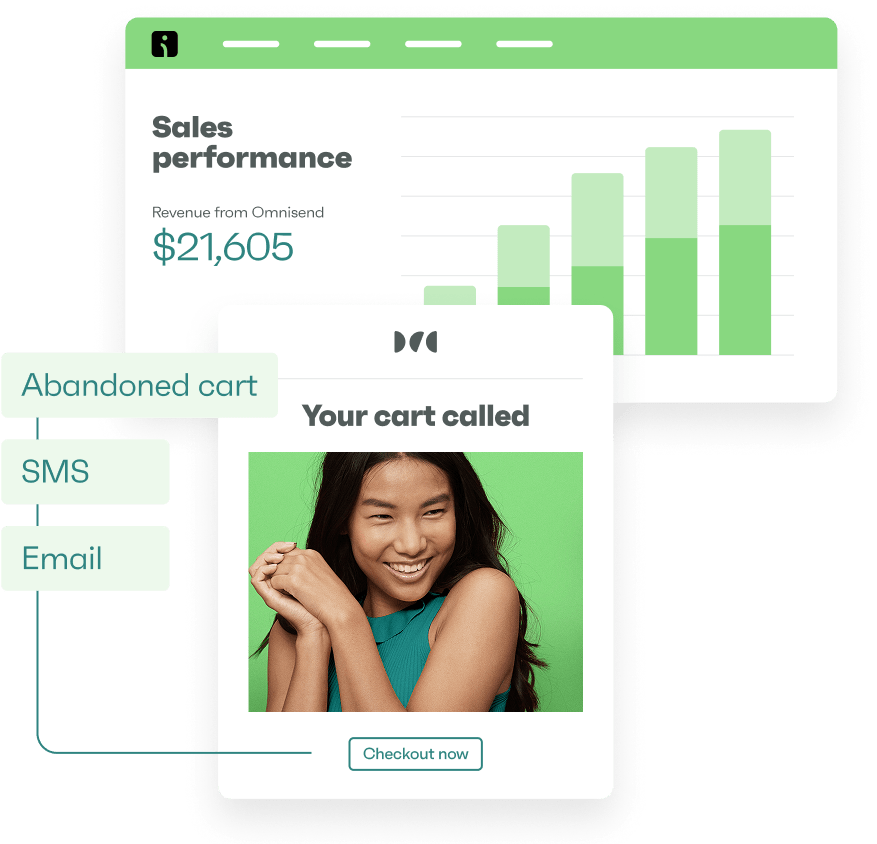Drive sales on autopilot with ecommerce-focused features
See FeaturesUnderstanding email correspondence meaning is essential for navigating daily business interactions. It’s one of the most effective ways to build trust and maintain professionalism in business relationships.
That said, email correspondence meaning isn’t just about sending messages to get replies, it’s about establishing clarity to enable clear decision-making. A well-crafted correspondence email can lead to measurable results, such as closing deals, securing partnerships, or building a professional network that directly impacts growth and revenue.
In this article, we’ll explore what email correspondence truly entails and its distinction from email marketing. We’ll also discuss key components and tips of email correspondence to inspire you to create impactful. Let’s begin.
Quick sign up | No credit card required
What is email correspondence?
Email correspondence is one-on-one communication between individuals, usually for work or other formal situations. Think of it as the digital version of professional letter writing. It needs to be clear, well-structured, and maintain a professional tone.
Email marketing vs. email correspondence
These two forms of email communication may sound similar, but they operate on vastly different levels and with distinct goals.
Since email correspondence aims to build relationships, solve problems, or get clear information about a person or business, maintaining a professional tone is key.
For instance, a professional inquiry might read: “Hello (Name), I’m reaching out to inquire about the next steps for the partnership proposal we discussed last week. Please let me know a convenient time for a call.” The focus here is on gathering information to move things forward.
In contrast, email marketing is a promotional strategy that involves sending bulk emails to drive sales and engage customers. An example of email marketing could be a promotional newsletter that reads: “Unlock 50% off your next purchase. Hurry, the clock is ticking!”
However, aside from the copy, elements such as the newsletter’s design, fonts, and layout also play a significant role in driving sales.
Email marketing is most effective when you need to reach a larger audience with a compelling offer, and you can use email marketing software like Omnisend to streamline the process.
Both email marketing and email correspondence are indispensable in modern communication and require attention to detail.
Email correspondence examples
Email correspondence can be used in professional and personal contexts, each with its own purpose and approach.
1. Professional inquiries
When you send professional inquiries, you initiate a focused conversation with a colleague, client, supplier, or potential business partner. Here’s an email correspondence example:
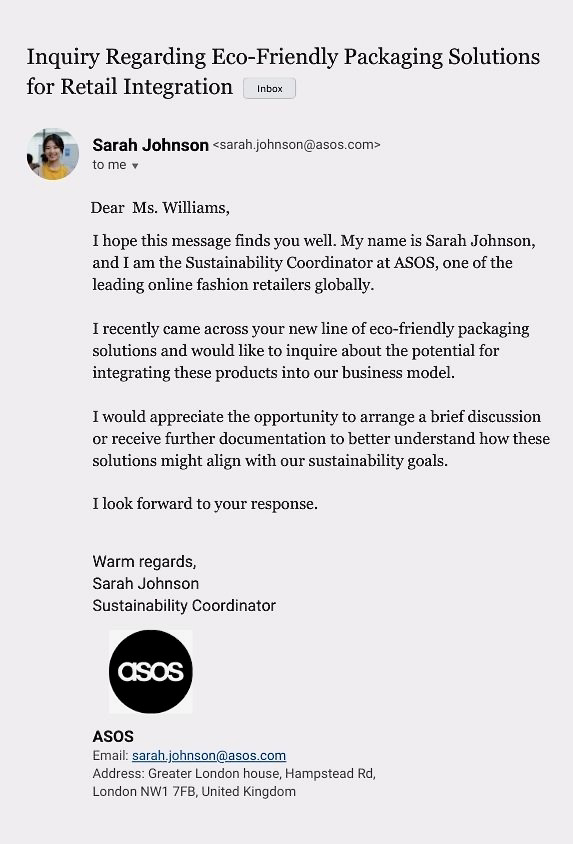
2. Follow-up emails
Follow-up emails continue previous interactions, ensuring that conversations progress smoothly and the main points aren’t overlooked.
For example, the email below has a straightforward subject line. The opening statement in the body shows gratitude for the prior meeting:
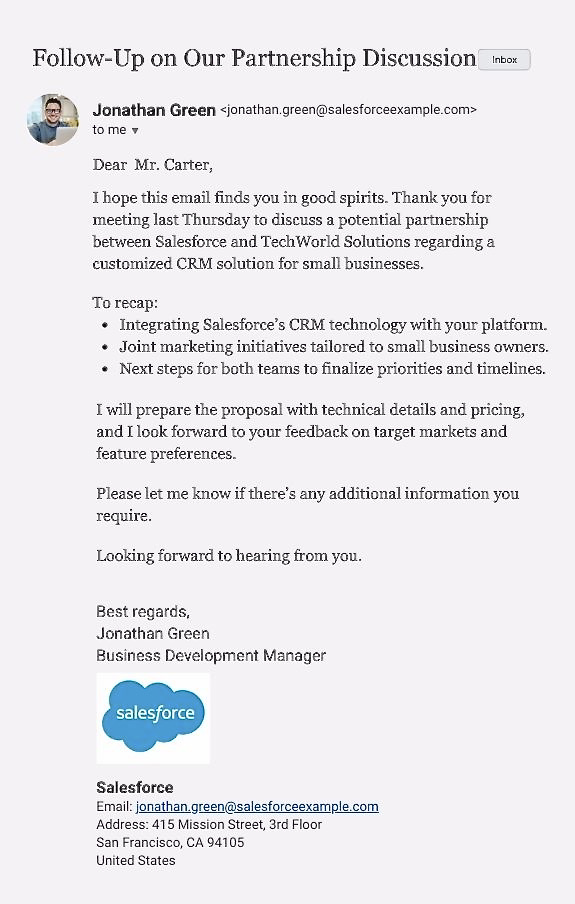
3. Personal updates
When sharing personal updates, such as personal milestones, the key is to share victory without bragging.
In the example below, the email shares an exciting achievement — expanding to New York — while maintaining a humble tone. It shows appreciation for the recipient’s past support, which creates a sense of involvement for the recipient:
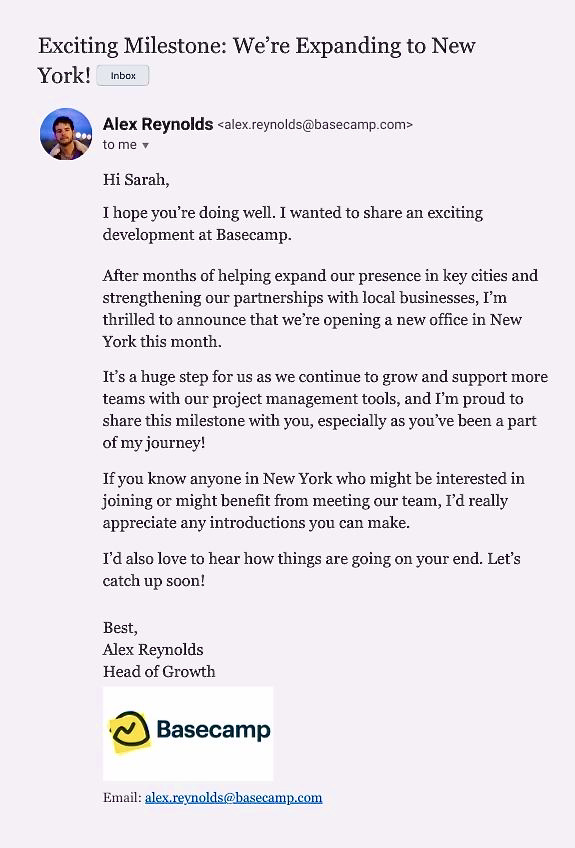
4. Thank you emails
These emails are an essential form of email correspondence to facilitate relationship-building by expressing appreciation.
Knowing how to write the thank you emails correctly reinforces appreciation when opened, creating an engaging and warm first impression.
These can be a part of email marketing campaigns but can also be used in professional emails. It’s best to use no more than two email fonts for professional email correspondence, as shown in this email example:
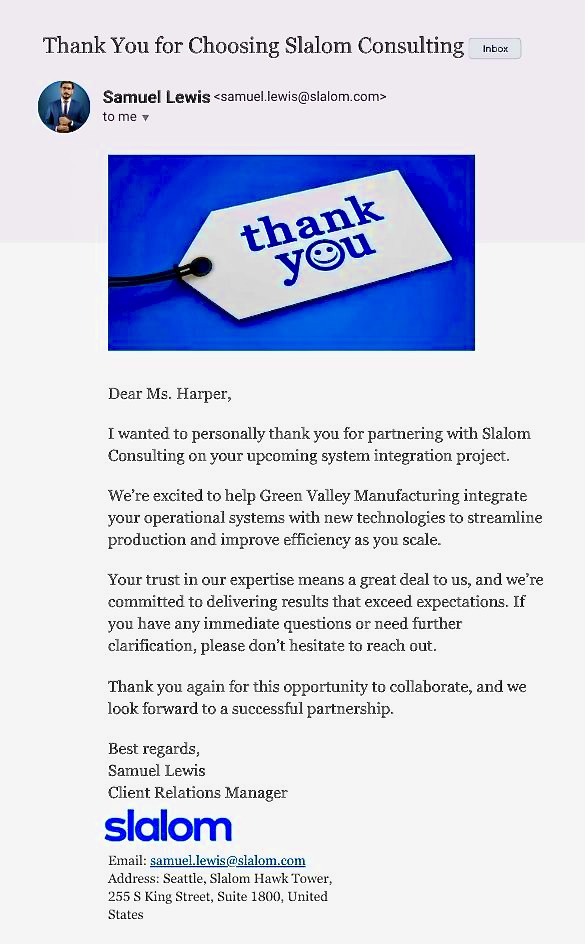
5. Introductory emails
The introduction emails are mistaken for welcome emails because they both serve as initial points of contact. Welcome emails are intended to engage customers who have already shown interest — in subscribing to a plan, whereas introductory emails focus on introducing a person or new product.
For example, this email example explains how the company’s new Inventory Management feature can improve control, visibility, and efficiency, which immediately addresses the recipient’s pain points:
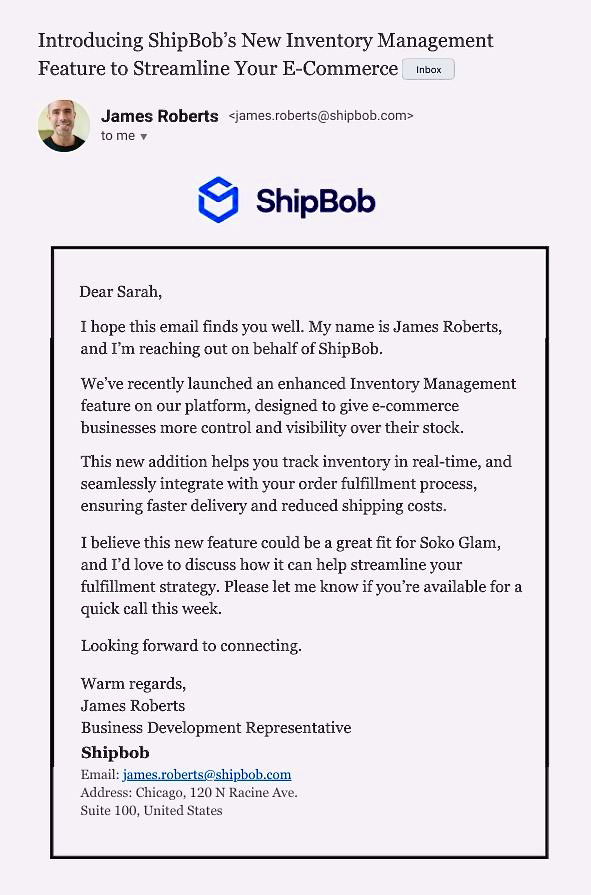
6. Apology emails
Sometimes, mistakes that call for an apology can happen in business. These apologies are often included in transactional emails like merchant-initiated order cancellations. In these cases, a company must express regret to the customer for the order cancellation.
For example, this apology email acknowledges and gives a reason for the delay in responding to the email and also reassures the recipient that the matter will be addressed promptly:
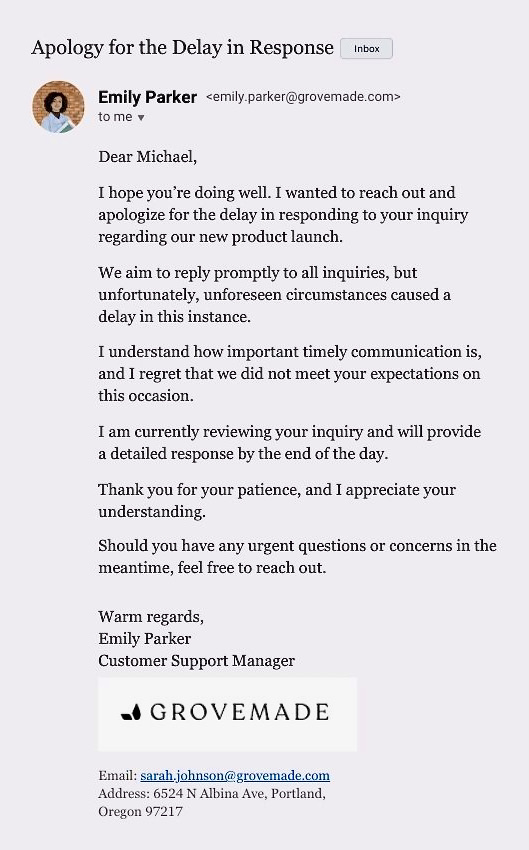
Benefits of effective email correspondence
Effective email correspondence sets the tone for future interactions. Whether you’re negotiating a deal or simply maintaining contact, your emails can either strengthen or undermine your position.
Mastering the art of effective email correspondence has the following benefits:
- Professionalism: Presenting yourself professionally increases the chances of getting timely responses and securing business opportunities. People are more likely to trust and collaborate with you when they perceive your communication as professional.
- Clarity: Effective email correspondence ensures clarity, making your message easy to understand and minimizing follow-ups. It also shows you respect the recipient’s time by avoiding unnecessary confusion in both business and personal communication.
- Documenting records for future reference: Email correspondence is a written record of agreements, decisions, and timelines and can be used legally as evidence in disputes. Additionally, it helps you stay organized and ensures you aren’t caught off-guard by forgotten commitments.
- Relationship building: This can include acknowledging a supplier’s timely delivery or offering personalized support to a business partner. Both actions help build trust and foster ongoing collaborations, which are key elements of effective email correspondence. They also contribute to a culture of mutual respect.

Important components of effective email correspondence
Effective email correspondence includes essential elements that ensure your message is right, clearly conveys its purpose, and guides the recipient toward an outcome.
Below are the core components that should be implemented in every correspondence email:
- Clear subject lines: The subject line should be direct and reflect the email’s purpose. Instead of cryptic, vague phrases, use subject lines that clearly convey the email’s purpose. A catchy, direct subject line helps the recipient immediately understand the value of the email, increasing the likelihood they’ll open it.
- Formal tone: A formal tone is usually expected for business correspondence, while a more relaxed tone may be appropriate for personal communication. However, always remain respectful, clear, and purposeful in your tone.
- Concise and actionable messaging: A key area of effective email correspondence is ensuring your email avoids unnecessary details. Get straight to the point. Your recipient’s time is precious. So, being succinct prevents confusion and helps avoid back-and-forth clarifications.
- Proper grammar: Nothing erodes trust faster than poorly written emails. Mistakes in grammar or punctuation can undermine the credibility of your message. Effective email correspondence begins with correct spelling, punctuation, and sentence structure. These may seem trivial, but a well-crafted email reflects your attention to detail.
- Personalization: A well-personalized email shows that you’ve taken the time to understand your recipient’s situation. It often references a past conversation or acknowledges preferences. Personalization can be the difference between a quick response and one that gets ignored in business and personal communication.
Tips for writing email correspondence
Whether you’re a professional or a beginner, consider taking into account the following tips before you hit send on that email:
- Proofread for accuracy: An unclear email can lead to missed opportunities. Ensure clarity in action items, such as requesting a colleague to review a document or confirm a meeting, to prevent misinterpretation.
- Maintain proper email structure: Start with a clear subject line, address the recipient by name, and use short paragraphs or bullet points for readability. Begin with a polite greeting and close with a courteous sign-off.
- Double-check your recipient fields: Ensure the correct recipients are in the CC and BCC fields before sending. For example, sending emails to the wrong person can lead to misunderstandings and privacy breaches.
- Include clear calls to action (CTAs): Every email should have a defined next step, like scheduling a meeting or reviewing a proposal. Use actionable language, such as “Please review and approve the attached report.”
- Leverage automation tools to streamline your process: Email automation simplifies creating, sending, and tracking emails. It ensures consistency while offering personalized touches through tailored templates. Tools like Omnisend can simplify the email creation process by providing pre-set templates, personalized messages, and scheduling options for hassle-free email management.
Email correspondence legality
Aside from effective communication, mastering email correspondence requires understanding legal obligations.
Privacy laws enacted by the European Union, such as the GDPR, set clear guidelines for how personal data, like email addresses, must be handled when exchanging emails.
GDPR mandates that:
- Consent must be obtained before collecting or sending any personal data, including email addresses
- Data minimization ensures that only the information necessary for communication is collected and shared
- Transparency requires that individuals are informed about how their data will be used and processed
- Right to access and deletion grants recipients the right to request access to their personal data or to have it deleted, ensuring they have control over how their information is handled
For example, if you’re sending an email using CC, all recipients can see each other’s email addresses. This could violate privacy laws if the recipients haven’t consented to share their personal information with others. Instead, BCC should be used to protect privacy.
Conclusion
To truly master email correspondence, you need to understand its meaning and its effects on professional communication. Simply put, each corresponding email you send is an opportunity to demonstrate clarity, establish authority, and control how you’re perceived, which can make or break relationships.
For effective email correspondence, it’s important to proofread your emails, maintain a proper email structure, double-check your recipient fields, and include clear subject lines and CTAs.
However, this process may feel overwhelming and time-consuming. That’s why leveraging tools like Omnisend to automate email correspondence can be a game-changer.
Quick sign up | No credit card required
TABLE OF CONTENTS
TABLE OF CONTENTS


No fluff, no spam, no corporate filler. Just a friendly letter, twice a month.

 OFFER
OFFER







